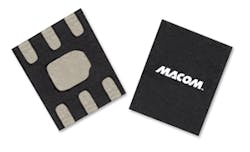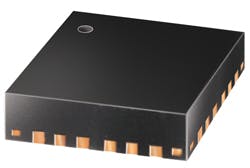Frequency Conversion Provides Communications Flexibility
This file type includes high resolution graphics and schematics when applicable.
Frequency conversion is an enabling technique for most communications systems and test equipment. By shifting signals with voice, video, and data content to higher frequencies, they can be transmitted and received with quarter-wavelength antennas that are much smaller for those higher frequencies.
At RF and microwave frequencies, systems designers have a number of frequency conversion options, with each offering its own strengths and weaknesses. As when selecting other components for a system design, a choice of frequency-conversion solution often comes down to size, cost, and frequency range.
Many of the basic requirements for a frequency-conversion component were reviewed in an earlier article. As that article notes, frequency mixers are among the most popular of frequency-conversion components, used to shift frequencies higher (upconversion) or lower (downconversion) as needed.
These three-port components, with radio frequency (RF), local oscillator (LO), and intermediate-frequency (IF) signal ports, work by mixing two signals to create a third. For upconversion, the two signals are added in frequency, whereas for downconversion, one of the signals is subtracted from the other.
Decades earlier, for those who may remember mixer suppliers such as Watkins-Johnson Co., Hewlett-Packard Co., and MACOM, frequency mixers were considerably larger. They were based on discrete-component circuits and supplied in metal housings with waveguide or coaxial connectors.
Modern demands for smaller, lighter communications equipment and portable radar systems have led to smaller integrated-circuit (IC) mixers in surface-mount-technology (SMT) housings. These may also contain associated circuit functions, such as amplifiers and filters. Low-cost housings can limit the frequency range of an IC mixer, although SMT packaging continues to improve well into the microwave frequency range.
Frequency mixers are available as both active or passive circuits, with a key different between the two types being whether frequency translation occurs with conversion loss (passive mixers) or conversion gain (active mixers). From a system design point of view, another different between an active and passive mixer may be the need to include additional amplification and filtering with the passive mixer compared to the “ready-to-go” nature of an active mixer.
Other specifications for comparing different mixers—as noted in that earlier article referenced above—include the usable frequency ranges of the three ports; the input and output VSWR; the amplitude levels of spurious signal products produced by the nonlinear mixing effects; the 1-dB compression point at the input of the mixer (the level at which the mixer’s conversion loss increases by 1 dB); single-tone and multiple-tone intermodulation distortion [including the input third-order intercept point (IIP3), or the level at which a mixer produces a specified spurious level]; the maximum and minimum LO power levels; the noise figure or noise added by the mixer to the output signals; and the isolation between ports (to prevent unwanted mixing of signals).
Mixers can be based on a single semiconductor device—such as a field-effect transistor (FET), a PIN diode, or a Schottky barrier diode—as well as on two semiconductor devices in a balanced configuration or four semiconductor mixing devices in a double-balanced configuration. Typically, the increasing number of active devices within a mixer can help low spurious signal content at the output and improve isolation between ports, with a tradeoff of higher conversion loss than a single-device mixer.
An additional mixer configuration, when high image rejection is needed, is the image-reject mixer, formed by connecting a pair of double-balanced mixers. The internal use of 90-deg. hybrids to split RF and LO signals to 0- and 90-deg. phase-offset signals for driving the two internal mixers—and then another 90-deg. hybrid for combining the two phase-offset IF signals into one output IF signal—accounts for higher loss than other mixer types with an image-reject mixer, and the need of more robust LO power and more consumption of power than other mixer types.
Similarly, in-phase/quadrature (I/Q), or single-sideband (SSB), mixers are also formed by connecting a pair of double-balanced mixers and feeding 0- and 90-deg. signals to LO ports of the two different mixers. Such mixers are commonly used for modulating and demodulated signals with quadrature modulation.
Because the phase cancellation network formed by the mixers and associated components add phase for one sideband and subtract phase for the other, this type of mixer can help remove the unwanted sideband during processing. This especially holds true if the sideband is relatively close to the desired signals (and possibly too close for effective filtering).
As noted earlier, mixers are increasingly available in SMT housings for higher-frequency applications, and the model MAMX-011021 passive frequency mixer from the aforementioned MACOM is an impressive example. Housed in a six-lead, plastic RoHS-compliant package that measures a mere 1.5 × 1.2 mm (Fig. 1), the mixer accepts RF signals from 5 to 35 GHz and LO signals from 3 to 33 GHz, producing IF signals from DC to 4.5 GHz with 8-dB conversion loss.
Multiplying Frequencies
Mixers may be the most oft-used RF/microwave component for frequency conversion, but they are not the only option. As with mixers, frequency multipliers continue to squeeze into smaller packages while reaching higher frequencies. Frequency multipliers (for frequency upconversion) and their counterparts, frequency dividers or prescalers (for frequency downconversion), are commonly used with integer multiplication or division factors of typically 2, 4, or 8. They are available in active and passive forms with multiplication and division factors of 12 and higher.
When more than one division ratio is required, dual-modulus prescalers are chip or packaged ICs with switchable division ratios, such as 8 and 9, 32 and 33, and 64 and 65. Typically, a simple control signal, such as a transistor-transistor-logic (TTL) command, selects the division ratio.
As with mixers, frequency multipliers and dividers rely on the nonlinear characteristics of semiconductor devices—such as transistors or diodes—to perform the harmonic multiplication or division required to produce higher or lower output frequencies, respectively. Both multipliers and dividers are available in numerous forms, including in coaxial and SMT packages, with power-handling capability typically a function of package size.
As with frequency mixers, frequency multipliers can be active or passive, based on various types of transistors or diodes, respectively. Multipliers can be based on a single diode for simplicity and in cases where the fundamental or carrier frequency signals can be readily suppressed. Balanced diode multipliers may yield higher conversion loss, but will also achieve better suppression of unwanted even-order spurious products and improved fundamental suppression.
In a frequency mixer, two signals are needed for frequency conversion. When only one signal source is available, and it is (for example) an LO that must be upconverted, a frequency multiplier provides a means of raising the frequency range of the LO with low loss and without introducing a great deal of noise. Frequency dividers are commonly used in phase-locked-loop (PLL) frequency synthesizer to downconvert the frequency of a tunable source, such as a voltage-controlled oscillator (VCO), to bring it into range of a phase detector for comparison with the phase of a reference oscillator.
Frequency multipliers and dividers are specified according to a set of parameters that is closely aligned to those of a frequency mixer. These include multiplication or division ratio; input and output frequency ranges; conversion loss or gain; maximum input power; maximum output power; fundamental (carrier) and harmonic rejection; current consumption; operating temperature range; and package style
Frequency multipliers operate by multiplying signal phase as part of the process and, in so doing, increase the phase noise of the multiplied signals even under ideal conditions. Even so, frequency multipliers offer a cost-effective means of generating high-frequency signals, especially beyond microwave frequencies.
The model HMC-XTB1100 is a monolithic frequency tripler from Analog Devices based on GaAs Schottky diode technology. It requires no DC power, but transforms input signals from 24 to 30 GHz to low-noise output signals from 72 to 90 GHz, all as part of a chip measuring 1.1 × 1.4 × 0.1 mm.
For those more comfortable with a packaged part, the model CY2-143+ (Fig. 2) from Mini-Circuits is a surface-mount frequency doubler that transforms an input frequency range from 2 to 7 GHz to an output frequency range of 4 to 14 GHz, with 12 to 13 dB typical conversion loss. The GaAs heterojunction-bipolar-transistor (HBT) monolithic-microwave-integrated-circuit (MMIC) doubler is supplied in a housing measuring just 4 × 4 × 1 mm.
Beyond mixers, prescalers, and multipliers, frequency translation is often added to a system in the form of an integrated front-end assembly (IFA) which typically combines a frequency mixer, LO, amplification, and filtering within a drop-in component housing. In the world of satellite communications, these assemblies are also known as block upconverters (BUCs) and block downconverters (BDCs).
The integration simplifies the matching of components (for the system-level designer), but requires that performance requirements are well known in advance. Some tuning flexibility is sacrificed as one of the tradeoffs for the ready-to-use frequency conversion assembly.
This file type includes high resolution graphics and schematics when applicable.
About the Author
Jack Browne
Technical Contributor
Jack Browne, Technical Contributor, has worked in technical publishing for over 30 years. He managed the content and production of three technical journals while at the American Institute of Physics, including Medical Physics and the Journal of Vacuum Science & Technology. He has been a Publisher and Editor for Penton Media, started the firm’s Wireless Symposium & Exhibition trade show in 1993, and currently serves as Technical Contributor for that company's Microwaves & RF magazine. Browne, who holds a BS in Mathematics from City College of New York and BA degrees in English and Philosophy from Fordham University, is a member of the IEEE.



